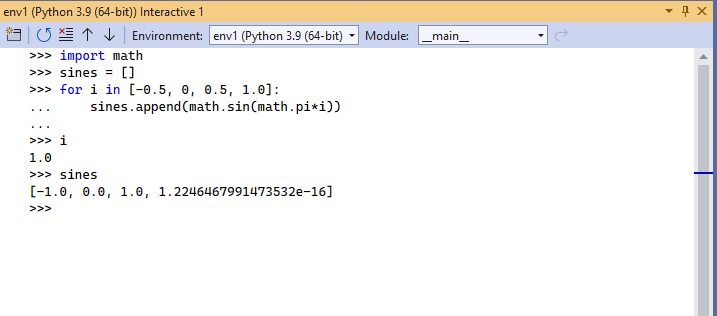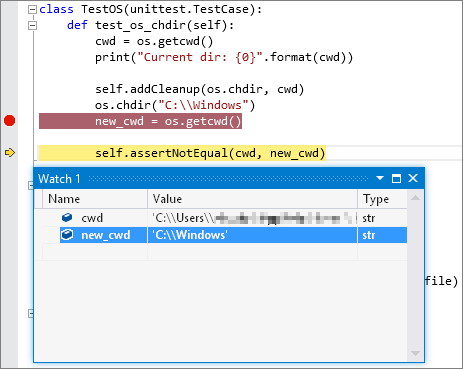Python-támogatás Windowson a Visual Studióban
A Python egy népszerű programozási nyelv, amely megbízható, rugalmas, könnyen elsajátítható, minden operációs rendszeren szabadon használható, és amelyet erős fejlesztői közösség és számos ingyenes kódtár is támogat. A Python minden fejlesztést támogat, beleértve a webalkalmazásokat, a webszolgáltatásokat, az asztali alkalmazásokat, a szkriptelést és a tudományos számítástechnikát. Tudósok, alkalmi fejlesztők, profi fejlesztők és számos egyetem egyaránt a Pythont használja programozáshoz. További információkat találhat a nyelvről a python.org és a Python kezdőknekwebhelyeken.
A Visual Studio egy hatékony Python IDE Windows rendszeren. A Visual Studio nyílt forráskódú támogatást nyújt a Python nyelvhez a Python Fejlesztési és Data Science számítási feladatain (Visual Studio 2017 és újabb verziók) és az ingyenes Python Tools for Visual Studio bővítményen keresztül (Visual Studio 2015 és korábbi verziók). A Visual Studio IDE bemutatása a Python-kód írásához és szerkesztéséhez használható IDE-funkciók megismeréséhez.
A Visual Studio Code Macen és Linuxon is elérhető. További információ: kérdések és válaszok.
Első lépések:
A Python-számítási feladat beállításához kövesse telepítési utasításokat.
A cikk szakaszaiban megismerkedhet a Visual Studio Python-képességeivel.
Egy projekt létrehozásához tekintse át az egyik vagy több rövid útmutatót. Ha nem biztos benne, kezdje rövid útmutatóval: Python-kód megnyitása és futtatása mappában vagy Webalkalmazás létrehozása a Flaskhasználatával.
A teljes körű felhasználói élmény érdekében kövesse a Python használata a Visual Studióban oktatóanyagot.
Több értelmező támogatása
A Visual Studio Python-környezetek ablaka egyetlen helyet biztosít az összes globális Python-környezet, Conda-környezet és virtuális környezet kezeléséhez. A Visual Studio automatikusan észleli a Python szabványos helyeken való telepítését, és lehetővé teszi egyéni telepítések konfigurálását. Az egyes környezetekkel egyszerűen kezelheti a csomagokat, megnyithat egy interaktív ablakot a környezet számára, és hozzáférhet a környezeti mappákhoz.
Az Interaktív ablak megnyitása paranccsal interaktívan futtathatja a Pythont a Visual Studio környezetében. A kijelölt környezet mappájában nyisson meg egy külön parancsablakot a Megnyitás a PowerShellben paranccsal. Ebben a parancsablakban bármilyen Python-szkriptet futtathat.
További információ:
Részletes szerkesztés, IntelliSense és kódértés
A Visual Studio első osztályú Python-szerkesztőt biztosít, beleértve a szintaxisszínezést, az automatikus kiegészítést az összes kód és kódtár között, a kódformázást, az aláírási súgót, az újrabontást, a lintinget és a gépelési tippeket. A Visual Studio olyan egyedi funkciókat is kínál, mint az osztálynézet, Ugrás a definícióra, Összes hivatkozás kereséseés kódrészletek. A interaktív ablak közvetlen integrációja segítségével gyorsan fejleszthet meglévő Python-kódot egy fájlban.

További információ:
Interaktív ablak
A Visual Studio által ismert összes Python-környezet esetében egyszerűen megnyithatja ugyanazt az interaktív (REPL) környezetet egy Python-értelmező számára közvetlenül a Visual Studióban, ahelyett, hogy külön parancssort használ. A környezetek között is könnyen válthat. Ha külön parancssort szeretne megnyitni, válassza ki a kívánt környezetet a Python-környezetek ablakban, majd válassza a Megnyitás a PowerShell-ben parancsot a Több értelmező támogatása szakaszban leírtak szerint.

A Visual Studio szoros integrációt biztosít a Python-kódszerkesztő és a Interaktív ablak között. A Ctrl+Enter billentyűparancsa kényelmesen elküldi a szerkesztő aktuális kódsorát (vagy kódblokkját) az Interaktív ablakba, majd a következő sorra (vagy blokkra) lép. Ctrl+Enter segítségével egyszerűen lépkedhet a kódon anélkül, hogy futtatnia kellene a hibakeresőt. A kijelölt kódot az Interaktív ablakba is elküldheti ugyanazzal a billentyűleütéssel, és egyszerűen beillesztheti a kódot az Interaktív ablakból a szerkesztőbe. Ezek a képességek együtt lehetővé teszik, hogy kidolgozza a kód egy részletének részleteit az Interaktív ablakban, és könnyen elmentse az eredményeket egy fájlba a szerkesztőben.
A Visual Studio az IPython/Jupytert is támogatja a REPL-ben, beleértve a beágyazott rajzokat, a .NET-et és a Windows Presentation Foundationt (WPF).
További információ:
Projektrendszer, projekt- és elemsablonok
A Visual Studio segítségével kezelheti egy projekt összetettségét, ahogy az idővel növekszik. A Visual Studio projekt több, mint mappastruktúra. A projekt segít megérteni a különböző fájlok használatát és azok egymáshoz való viszonyát. A Visual Studio segít megkülönböztetni az alkalmazáskódot, a tesztkódot, a weblapokat, a JavaScriptet, a build szkripteket stb., ami lehetővé teszi a fájltípusnak megfelelő funkciók használatát. A Visual Studio megoldás segít több kapcsolódó projekt, például egy Python-projekt és egy C++ bővítményprojekt kezelésében.
Jegyzet
A Visual Studio 2019-ben és újabb verzióiban megnyithat egy Python-kódot tartalmazó mappát, és futtathatja azt Visual Studio-projekt vagy megoldásfájl létrehozása nélkül. További információ: Rövid útmutató: Python-kód megnyitása és futtatása egy mappában. Ne feledje, hogy a projektfájlok használatának előnyei az ebben a szakaszban ismertetett módon érhetők el.
Az alábbi képen egy Visual Studio-megoldás látható, amely Python- és Flask-projekteket is tartalmaz Megoldáskezelő.
A projekt- és elemsablonok automatizálják a különböző típusú projektek és fájlok beállításának folyamatát. A sablonok értékes időt takaríthatnak meg, és megkönnyítik a bonyolult és hibalehetőségekkel kapcsolatos részletek kezelését. A Visual Studio sablonokat biztosít a webhez, az Azure-hoz, az adatelemzéshez, a konzolhoz és más típusú projektekhez. Sablonokat találhat olyan fájlokhoz, mint a Python-osztályok, az egységtesztek, az Azure-webkonfiguráció, a HTML és még a Django-alkalmazások is.
További információ:
- Python-projektek kezelése
- Elem sablonok hivatkozása
- Python-projektsablonok
- A C++ és a Python használata
- Projekt- és elemsablonok létrehozása
- Megoldások és projektek a Visual Studio
Teljes funkcionalitású hibakeresés
A Visual Studio egyik erőssége a hatékony hibakereső. Különösen a Python esetében a Visual Studio tartalmazza a Python/C++ vegyes módú hibakeresési, a linuxos távoli hibakeresést, az interaktív ablakban végzett hibakeresést és a Python-egységtesztek hibakeresését.

A Visual Studio 2019-ben és újabb verzióiban Visual Studio-projektfájl nélkül futtathat és hibakeresést végezhet a kódban. Lásd például rövid útmutatót: Python-kód megnyitása és futtatása egy mappában.
További információ:
- Python- hibakeresése
- Python/C++ vegyes módú hibakeresési
- Távoli hibakeresés Linux
- Visual Studio Hibakereső funkcióbemutatója
Profilkészítési eszközök átfogó jelentéskészítéssel
A profilkészítés azt mutatja be, hogy mennyi időt töltenek az alkalmazáson belül. A Visual Studio cPython-alapú értelmezőkkel támogatja a profilkészítést, és lehetővé teszi a különböző profilkészítési futtatások teljesítményének összehasonlítását.
További információ:
Egységtesztelési eszközök
A Visual Studio Test Explorertesztjeinek felderítése, futtatása és kezelése, valamint az egységtesztek egyszerű hibakeresése.

További információ:
Azure SDK for Python
A PythonHoz készült Azure-kódtárak leegyszerűsítik az Azure-szolgáltatások használatát Windows, macOS X és Linux rendszerű alkalmazásokból. Ezek használatával Azure-erőforrásokat hozhat létre és kezelhet, és csatlakozhat az Azure-szolgáltatásokhoz.
További információ: Az Azure SDK a Pythonhoz és Az Azure könyvtárak a Pythonhoz.
Kérdések és válaszok
Q. Elérhető a Python-támogatás a Mac Visual Studióval?
A. A Visual Studio for Mac nem támogatott. További információkért lásd: Mi történik a Visual Studio for Mac-kel? A Visual Studio Code Windows, Mac és Linux rendszeren jól működik a Python-nal az elérhető bővítmények segítségével.
Q. Mire használható a felhasználói felület létrehozása a Pythonnal?
Egy. A fő ajánlat ezen a területen a Qt Project Python kötésekkel, amely az PySide (a hivatalos kötés) (lásd a PySide letöltések) és PyQt. A Visual Studio Python-támogatása nem tartalmaz felhasználói felületi fejlesztéshez szükséges eszközöket.
Q. Létrehozhat egy Python-projekt önálló végrehajtható fájlt?
Egy. A Python általában értelmezett nyelv, ahol a kódokat igény szerint futtatják egy megfelelő Python-kompatibilis környezetben, például a Visual Studióban és a webkiszolgálókon. A Visual Studio jelenleg nem biztosítja az önálló végrehajtható fájlok létrehozásához szükséges eszközöket, ami lényegében beágyazott Python-értelmezővel rendelkező programot jelent. A Python-közösség azonban különböző módokat kínál a végrehajtható fájlok létrehozásához a Stack Overflow. A CPython támogatja a natív alkalmazásokba való beágyazást is, a blogbejegyzésben leírtak szerint A CPython beágyazható zip-fájljának használata.





